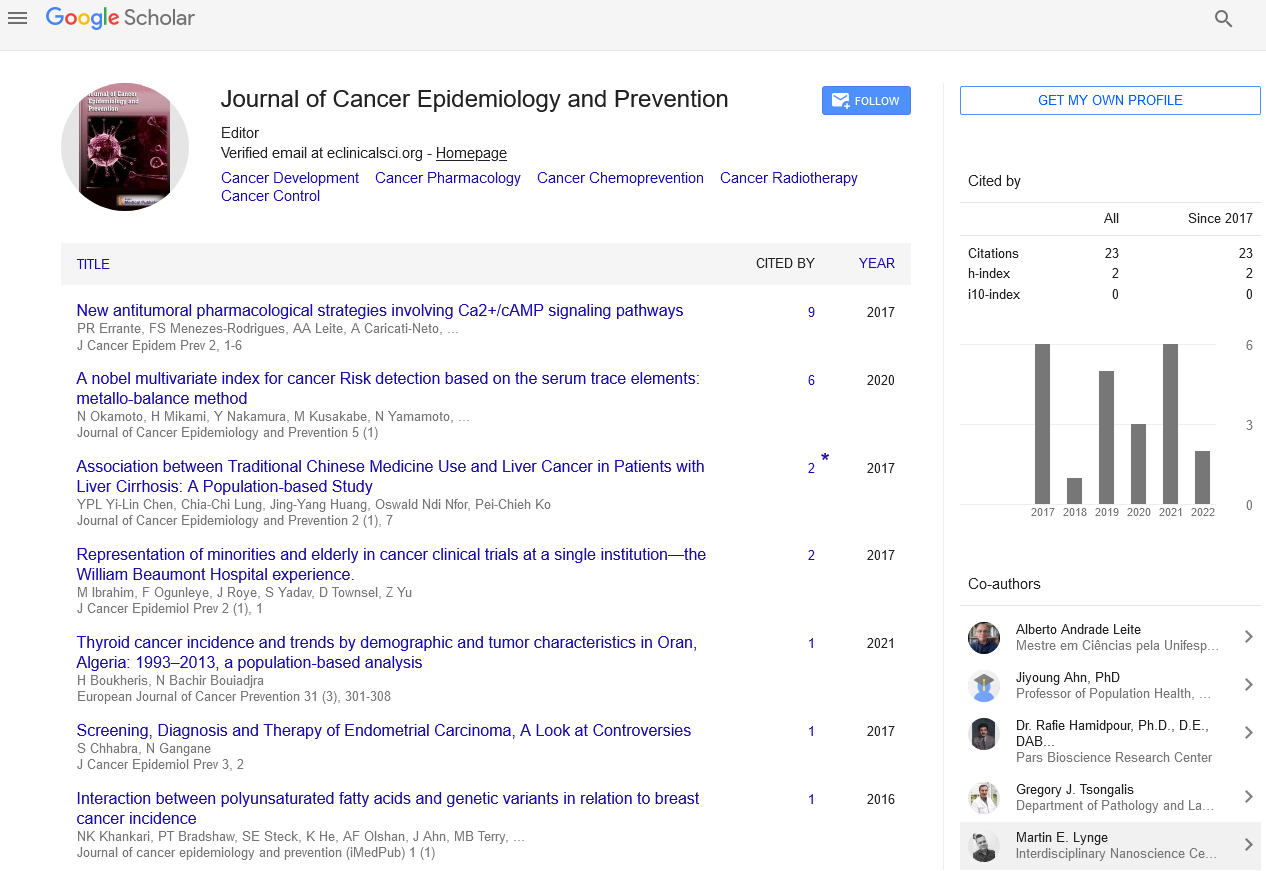Perspective - (2022) Volume 7, Issue 1
An Overview on Esophageal Cancer
Long Hu*
Department of Lung Cancer, Sichuan University, China
*Correspondence:
Long Hu, Department of Lung Cancer, Sichuan University,
China,
Email:
Received: 26-Jan-2022, Manuscript No. IPJCEP-22-12868;
Editor assigned: 28-Jan-2022, Pre QC No. IPJCEP-22-12868 (PQ);
Reviewed: 11-Feb-2022, QC No. IPJCEP-22-12868;
Revised: 16-Feb-2022, Manuscript No. IPJCEP-22-12868 (R);
Published:
23-Feb-2022, DOI: 10.36648/ipjcep.7.1.001
Introduction
Esophageal disease is a rare kind of throat cancer. Esophageal
illness manifests itself in the tissues and cells of the throat as
odd, uncontrolled cell growth. This disease can affect surrounding
tissues and spread (metastasize) to distant essential tissues
or organs via the circulatory system, lymphatic system, or other
mechanisms. From the back of the throat to the stomach, the
throat is a solid cylinder. A mucous film, a type of tissue that
secretes body fluid, is used to keep the neck in place. Oil and
safety come from bodily fluid. The throat is about 9 inches long
in most people.
The majority of esophageal malignant development begins in
the cells that border the bulk of the throat, eventually forming
a cancer. The cancerous growth can then partially block the
esophageal cylinder, making it difficult for food to reach the
stomach. Squamous cell carcinoma or adenocarcinomas are
the most common kinds of esophageal malignancy, accounting
for more than 95% of cases. The extra structures include fascinating
examples of lymphoma, melanoma, carcinoid growths,
leiomyosarcoma, and sarcoma in the throat. Malignant growth
that appears in another part of the body might move to the
throat in some bizarre circumstances.
Description
Esophageal disease may not be associated with any side effects
in the early stages. Affected persons may have difficulty gulping
strong food sources as the cancerous development progresses
(dysphagia). This occurs when the malignancy has progressed
to the point where it is obstructing the esophageal cylinder.
Initially, this may have an impact on specific food types, such as
meat, apples, or bread, which can “stick” in the throat. Eventually,
persons who have been affected may have difficulty
swallowing liquids. Many people may experience pain while attempting
to swallow (odynophagia). This is especially common
with dry food varieties, and it can help distinguish between malignant
growth and more benign causes of gulping problems.
Many people may experience pain while attempting to swallow (odynophagia). This is especially common with dry food varieties,
and it can help distinguish between malignant growth
and more benign causes of gulping problems. Additional side
effects include unintended weight loss, acid reflux (dyspepsia),
chest pain, and indigestion that are resistant to medication.
The most well-known side effects include a combination of difficulty
swallowing and unintentional weight loss.
Due to esophageal malignant development, persons who are
affected may also have frequent blood loss. This can lead to
iron deficiency. Paleness is a condition in which there are few
red platelets running through the bloodstream. The red platelets
transport oxygen throughout the body. Weariness, fair
skin tone (whiteness), discombobulation, and various adverse
effects are all associated with frailty. Sickness can occur as a result
of undiscovered gastrointestinal death, which can manifest
as dark, sticky faces if severe.
The enlargement of the lymph hubs in the neck (cervical
lymphadenopathy), regurgitating blood (hematemesis), hacking
up blood (hemoptysis), and dryness are all possible adverse
effects. Dryness is most commonly caused by the growth pushing
on (packing) the nerves of the vocal lines. Hiccups or spinal
pain might be caused by pressure on other nearby nerves.
Agony may affect the back, the region behind the breastbone
(retrosternal region), or the upper right part of the mid-region
if the malignancy has grown sufficiently enough.
People may develop a fistula, which is a weird connection between
the throat and the abdomen (windpipe). The windpipe
is a cylinder that connects the throat to the lungs (aviation
route). It runs from the throat’s voice box (larynx) to the lungs.
A tracheoesophageal fistula occurs when there is an unexpected
connection between the throat and the windpipe (TEF).
A TEF can cause breathing (respiratory) problems and pneumonia
by allowing food or other foreign particles to enter the
lungs (yearning).
Conclusion
Esophageal cancer can spread (metastasize) to other parts of the body, including the liver, lungs, bone, and mind, causing
recurrence. The specific side effects that develop will be determined
by the disease’s location and severity. Esophageal illness
frequently extends to the liver, causing fever and abnormal liver
expansion (hepatomegaly). Spread to the lungs might result
in a chronic cough, wind, or an accumulation of liquid inside
the pleura (the membrane that surrounds the lungs) (pleural
emanation). Bone agony might occur if the infection spreads to
the bones. Spread to the mind can cause headaches, disorganization, and seizures.
Acknowledgement
None.
Conflict of Interest
The author declares there is no conflict of interest in publishing
this article.
Citation: Hu L (2022) An Overview on Esophageal Cancer. J Cancer Epidemiol Prev. 7:001
Copyright: © Hu L. This is an open-access article distributed under the terms of the Creative Commons Attribution License, which permits unrestricted use, distribution, and reproduction in any medium, provided the original author and source are credited.

